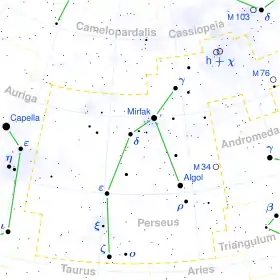43 Persei
43 Persei is a binary star[7][11] system in the northern constellation Perseus. It is visible to the naked eye as a dim, yellow-white hued star with an apparent visual magnitude of 5.28.[2] The system is located around 38.5 parsecs (125.4 ly) distant from the Sun, based on parallax.[1]
| Observation data Epoch J2000 Equinox J2000 | |
|---|---|
| Constellation | Perseus |
| Right ascension | 03h 56m 36.52069s[1] |
| Declination | 50° 41′ 43.3646″[1] |
| Apparent magnitude (V) | 5.28[2] |
| Characteristics | |
| Spectral type | F5V[3] |
| U−B color index | +0.00[4] |
| B−V color index | +0.41[4] |
| Astrometry | |
| Radial velocity (Rv) | +39.10[5] km/s |
| Proper motion (μ) | RA: +92.450[1] mas/yr Dec.: -129.755[1] mas/yr |
| Parallax (π) | 26.0059 ± 0.1271[6] mas |
| Distance | 125.4 ± 0.6 ly (38.5 ± 0.2 pc) |
| Absolute magnitude (MV) | 2.23[2] |
| Orbit[7] | |
| Period (P) | 30.438 days |
| Semi-major axis (a) | ≥ 16 Gm (0.11 AU) |
| Eccentricity (e) | 0.631 |
| Periastron epoch (T) | 2,440,873.14 JD |
| Argument of periastron (ω) (secondary) | 27.07° |
| Semi-amplitude (K1) (primary) | 51.85 km/s |
| Semi-amplitude (K2) (secondary) | 54.40 km/s |
| Details | |
| Mass | 1.54[8] M☉ |
| Radius | 2.4[8] R☉ |
| Luminosity | 10.81[2] L☉ |
| Surface gravity (log g) | 4.12[9] cgs |
| Temperature | 6,609[9] K |
| Metallicity [Fe/H] | 0.00[2] dex |
| Rotational velocity (v sin i) | 17[10] km/s |
| Other designations | |
| Database references | |
| SIMBAD | data |
This is a double-lined spectroscopic binary with an orbital period of 30.4 days and an eccentricity of 0.6.[7] The primary component is an F-type main-sequence star with a stellar classification of F5V,[3] a star that is fusing its core hydrogen. It has 1.54[8] times the mass of the Sun, 2.4[8] times the Sun's radius, and is spinning with a projected rotational velocity of 17 km/s (11 mi/s).[10] The star shines 10.8[2] times brighter than the Sun at an effective temperature of 6,609 K (6,336 °C; 11,437 °F).[9]
There are distant companions B (separation 75.5" and magnitude 10.66), C (separation 85.6" and magnitude 12.18), and D (separation 68" and magnitude 13.43).[12]
References
- Van Leeuwen, F. (2007). "Validation of the new Hipparcos reduction". Astronomy and Astrophysics. 474 (2): 653. arXiv:0708.1752. Bibcode:2007A&A...474..653V. doi:10.1051/0004-6361:20078357. Vizier catalog entry
- Anderson, E.; Francis, Ch. (2012). "XHIP: An extended hipparcos compilation". Astronomy Letters. 38 (5): 331. arXiv:1108.4971. Bibcode:2012AstL...38..331A. doi:10.1134/S1063773712050015. Vizier catalog entry
- Abt, Helmut A. (2009). "Mk Classifications of Spectroscopic Binaries". The Astrophysical Journal Supplement Series. 180: 117. Bibcode:2009ApJS..180..117A. doi:10.1088/0067-0049/180/1/117.
- Mallama, A. (2014). "Sloan Magnitudes for the Brightest Stars". The Journal of the American Association of Variable Star Observers. 42: 443. Bibcode:2014JAVSO..42..443M.Vizier catalog entry
- Gontcharov, G. A. (2006). "Pulkovo Compilation of Radial Velocities for 35 495 Hipparcos stars in a common system". Astronomy Letters. 32 (11): 759. arXiv:1606.08053. Bibcode:2006AstL...32..759G. doi:10.1134/S1063773706110065.
- Brown, A. G. A.; et al. (Gaia collaboration) (August 2018). "Gaia Data Release 2: Summary of the contents and survey properties". Astronomy & Astrophysics. 616. A1. arXiv:1804.09365. Bibcode:2018A&A...616A...1G. doi:10.1051/0004-6361/201833051. Gaia DR2 record for this source at VizieR.
- Wallerstein, George (February 1973). "Improved Elements for the Hyades Group Binary 43 Persei". Publications of the Astronomical Society of the Pacific. 85 (503): 115. Bibcode:1973PASP...85..115W. doi:10.1086/129417.
- Allende Prieto, C.; Lambert, D. L. (1999). "Fundamental parameters of nearby stars from the comparison with evolutionary calculations: Masses, radii and effective temperatures". Astronomy and Astrophysics. 352: 555. arXiv:astro-ph/9911002. Bibcode:1999A&A...352..555A. Vizier catalog entry
- David, Trevor J.; Hillenbrand, Lynne A. (2015). "The Ages of Early-Type Stars: Strömgren Photometric Methods Calibrated, Validated, Tested, and Applied to Hosts and Prospective Hosts of Directly Imaged Exoplanets". The Astrophysical Journal. 804 (2): 146. arXiv:1501.03154. Bibcode:2015ApJ...804..146D. doi:10.1088/0004-637X/804/2/146. Vizier catalog entry
- Hoffleit, D.; Warren, W. H. (1995). "VizieR Online Data Catalog: Bright Star Catalogue, 5th Revised Ed. (Hoffleit+, 1991)". VizieR On-line Data Catalog: V/50. Originally Published in: 1964BS....C......0H. 5050. Bibcode:1995yCat.5050....0H.
- Eggleton, P. P.; Tokovinin, A. A. (2008). "A catalogue of multiplicity among bright stellar systems". Monthly Notices of the Royal Astronomical Society. 389 (2): 869. arXiv:0806.2878. Bibcode:2008MNRAS.389..869E. doi:10.1111/j.1365-2966.2008.13596.x. Vizier catalog entry
- Mason, Brian D.; Wycoff, Gary L.; Hartkopf, William I.; Douglass, Geoffrey G.; Worley, Charles E. (2001). "The 2001 US Naval Observatory Double Star CD-ROM. I. The Washington Double Star Catalog". The Astronomical Journal. 122 (6): 3466. Bibcode:2001AJ....122.3466M. doi:10.1086/323920. Vizier catalog entry
